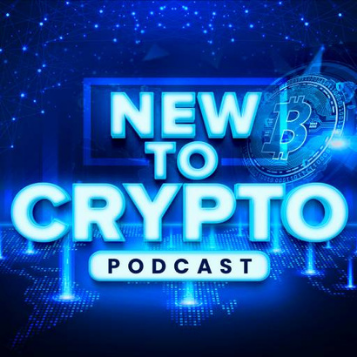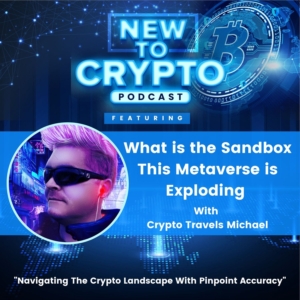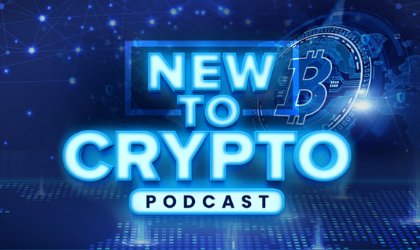Unknown Speaker 0:00
Welcome to the New To Crypto podcast designed to guide you through the crypto landscape with pinpoint accuracy created for the new and intermediate crypto investor. Join your host Crypto Travels Michael as he takes you through the different facets of getting started and succeeding in your crypto journey. New to crypto podcast brings you new episodes daily Monday through Friday with surprise bonus episodes sometimes on the weekend. Let me ask you, are you new to crypto don’t know where to start? Are you more experienced but have questions? Then you’re in the right place. This podcast is designed for you, coming at you from the training center in the lifestyle design studio. Here’s your host Crypto Travels Michael.
Michael 0:51
I’ll tell you this has been an exciting time in crypto, Bitcoin just hit an all time high busting through $66,000 per token. And there’s a tremendous amount of interest in crypto overall currently, and we just expect to see the industry continue to explode. So today’s episode is really an interesting one. It’s one of the most popular token projects in crypto. So today’s episode is all about what is Litecoin. Litecoin is one of the most recognized all coins in the entire crypto world. So this cryptocurrency was basically born in October of 2011. And it was an alternative to Bitcoin. In fact, Litecoin is a fork of the bitcoin core software with the aim of improving Bitcoin. The Creator Charlie Lee is one of the most recognized people for the project and most recognized people in all of crypto. So Lee actually left his job at Google to devote himself entirely on the development of Litecoin LTC.
Among its main proposals Litecoin seeks to be a cryptocurrency with a faster block generation, cheaper commissions and an efficient alternative for payments. Litecoin allows fast payments since it is focused on the E-commerce segment. So let’s break down and unpack a little bit about the technology of Litecoin. Litecoin defined itself as a Bitcoin clone created directly from its source code. It also stated that certain improvements had been made and some of the variables for the new network in cryptocurrency had been modified. The Genesis block of this cryptocurrency was created on October 13, 2011. On that day, this new cryptocurrency officially began to operate. Litecoin intends to solve the problems that Bitcoin had among these are: failure and receiving some transactions (this was initially back in 2011), high cost of hardware and energy for mining, high commissions for transactions and scalability. The success of the project led to it reaching a market cap of $1,000,000,000. years later in November of 2013. Litecoin has a limit of 84 million tokens or coins available. Its consensus mechanism is based on proof of work and the hash function it uses a script. The algorithm is significantly lighter than the SHA-256, but without promising security, being open source development for the entire community. Litecoin is a cryptocurrency whose block generation takes two and a half minutes so the Litecoin network is four times faster than Bitcoin. In addition, the average block weight is 65k B.
So its blockchain is very light, like Bitcoin. Litecoin relies on halving to control its issuance and block rewards for miners. Unlike Bitcoin, in LTC halving happens every 140,000 blocks, in Bitcoin happens every 210,000. The last halving in Litecoin, happened on August 5, 2019. The event brought block rewards of 25 LTC blocks down to 12 and a half, and the next halving will happen on August 6, 2023. Like all current cryptocurrencies, Litecoin suffers from transaction validation a challenge it must face in order to compete at a high level. Bitcoin allows to verify seven transactions per second, Ethereum allows to validate 15 transactions per second, visa allows to validate 56,000 transactions per second. Litecoin supports to validate 56 transactions per second. So what are the benefits the first major difference between LTC and Bitcoin is the generation of blocks, a block is generated every 10 minutes in Bitcoin but in the case of Litecoin, or the token is called LTC. It happens every two and a half minutes.
This is something that makes it possible to create greatly reduce the speed of transaction validation. This is possible because this cryptocurrency changes its protocol with respect to Bitcoin. The Bitcoin hash function is SHA-256. While LTC uses a script function, a lighter algorithm. Thanks to this, it is possible to create blocks less than one megabyte, they also allow them to be open in a faster and more agile way. In order to validate transactions more easily. One of the big problems of Bitcoin is scalability. The original idea was to process a maximum of seven transactions per second, which is currently a problem. It should be noted that initially, such a strong adoption was not foreseen, and now programmers are faced with finding a solution to that problem. However, LTC presents a solution to this problem supporting a maximum of 56 transactions per second, statistically, it is stronger than Bitcoin and other cryptocurrencies, such as Ethereum, which support up to 15 transactions per second, because all cryptocurrencies are at a very primary stage, work is being done to improve these options. The goal is to rival and surpass other payment solutions such as Visa. In fact, Visa currently supports 56,000 transactions per second. This is a problem that is being faced and will be solved definitely in the coming years.
Although currently we already use options such as Lightning Network that allow instant transactions or near instant finality, like Bitcoin Litecoin uses proof of work, but it differs in the hardware required to mine this cryptocurrency. Initially, due to the low initial competition in Bitcoin, it was possible to mined blocks using the CPU power of personal computers. But as the price of Bitcoin rose, so did the competition to mined blocks. So now more powerful hardware, such as GPUs came into play, and even custom hardware developed by ASICs and others. Litecoin can currently be mined with a processor and a graphics card, although there are also specific ASICs, machines for this cryptocurrency the difficulty which is based on the power of the network is still not very high, and a relatively decent amount of tokens can still be obtained when mining. LTC has blocks every two and a half minutes on average, which is four times shorter than bitcoins average block of time of 10 minutes, but the differences don’t stop there.
While Bitcoin has a maximum of approximately 21 million tokens available. The maximum number of tokens for LTC is at 4 million. In addition to reduction of coin issuance in each block, or halving, in Bitcoin occurs every 210,000 blocks, as I previously mentioned, but for Litecoin, it’s every 140,000 blocks. So as I previously mentioned, Charlie Lee is the founder created Litecoin, and he’s a computer scientist, and he serves as Managing Director of the Litecoin foundation. So let me go over some numbers for the LTC token. Currently, the market cap is just over 12.9 billion and the current price of LTC is trading at just over $188, and the circulating supply is 68.8 million tokens. It’s actually just slightly higher than that. So I hope this has been informative for you and has painted a picture as to what is LTC and what is Litecoin. If you liked today’s episode, definitely like and subscribe to the podcast. I’m working hard right now on bringing some really great episodes upcoming and I look forward to joining you here and until the next one, make it a great day.
Unknown Speaker 8:50
Thanks for tuning in to New To Crypto podcast. If you liked the episode, be sure to follow and subscribe. You can listen to every episode on all major platforms. Have an interest in being on the show or want advertising reach out at newtocrypto.io. Head over to our site newtocrypto.io to access the resources mentioned in each episode. Until next time, remember to navigate the crypto landscape with pinpoint accuracy.








![What is Litecoin: One of the Oldest Cryptocurrencies [Explained]](https://newtocrypto.io/wp-content/uploads/2021/11/What-is-Litecoin-One-of-the-Oldest-Cryptocurrencies-Explained-330x310.jpg)





